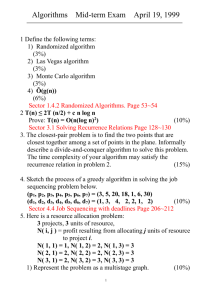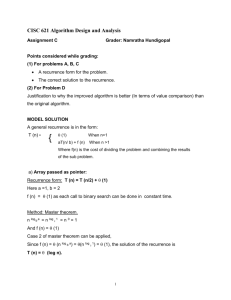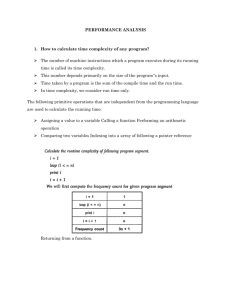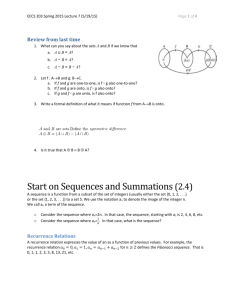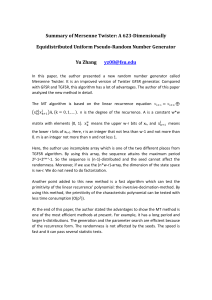The Shape of the Value Sets of Linear Recurrence Sequences d
advertisement
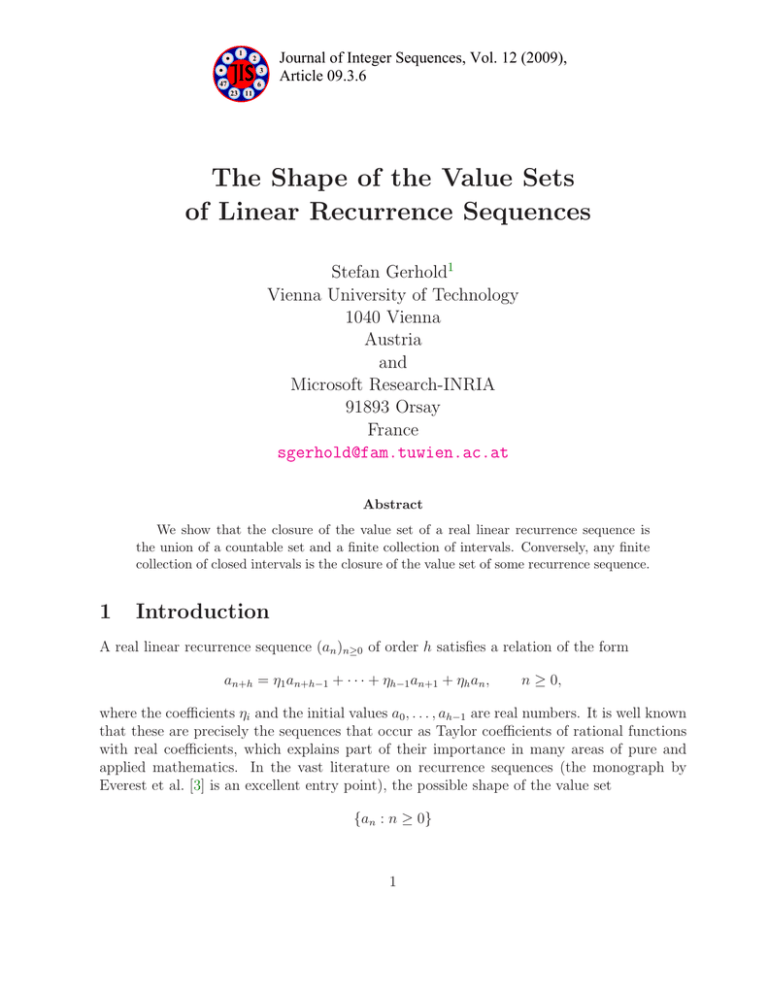
1
Journal of Integer Sequences, Vol. 12 (2009),
Article 09.3.6
2
3
47
6
23 11
The Shape of the Value Sets
of Linear Recurrence Sequences
Stefan Gerhold1
Vienna University of Technology
1040 Vienna
Austria
and
Microsoft Research-INRIA
91893 Orsay
France
sgerhold@fam.tuwien.ac.at
Abstract
We show that the closure of the value set of a real linear recurrence sequence is
the union of a countable set and a finite collection of intervals. Conversely, any finite
collection of closed intervals is the closure of the value set of some recurrence sequence.
1
Introduction
A real linear recurrence sequence (an )n≥0 of order h satisfies a relation of the form
an+h = η1 an+h−1 + · · · + ηh−1 an+1 + ηh an ,
n ≥ 0,
where the coefficients ηi and the initial values a0 , . . . , ah−1 are real numbers. It is well known
that these are precisely the sequences that occur as Taylor coefficients of rational functions
with real coefficients, which explains part of their importance in many areas of pure and
applied mathematics. In the vast literature on recurrence sequences (the monograph by
Everest et al. [3] is an excellent entry point), the possible shape of the value set
{an : n ≥ 0}
1
of such sequences seems not to have been worked out. Typical recurrence sequences are, e.g.,
constant sequences, 2n , (−1)n , and cos n. The first three of these have discrete value sets,
whereas the latter, which satisfies the recurrence
an+2 = 2 cos(1)an+1 − an ,
n ≥ 0,
(1)
is dense in the interval [−1, 1], by a classical result in Diophantine approximation [2]. This
is essentially the full picture, the precise statement being as follows.
2
Main Result
Theorem 1. The closure of the value set of a real linear recurrence sequence is the union of a
countable set and a finite collection of intervals. Conversely, any finite non-empty collection
of closed intervals is the closure of the value set of a recurrence sequence.
Proof. It is well known that any real recurrence sequence has a representation
an = |α|n (nd bn + O(nd−1 )),
n → ∞,
where d is a non-negative integer, α ∈ C is a dominating root of the characteristic polynomial
z h − η1 z h−1 − · · · − ηh−1 z − ηh ,
and the bounded real sequence (bn ) depends on the arguments of the dominating characteristic roots; see, e.g., Bell and Gerhold [1] for detailed formulas. Now if |α| =
6 1, or |α| = 1
and d ≥ 1, then |an | tends to zero or infinity; in both cases, the closure of its value set is
trivially at most countably infinite. The interesting case is |α| = 1 and d = 0, so that
an = bn + o(1).
(2)
The sequence (bn ) can be written as [1]
b n = un + v n ,
(3)
where (un ) is a periodic sequence (corresponding to characteristic roots with arguments that
are commensurate to π), and (vn ) can be split into g sections
vgn+k =
r
X
i=1
ξi cos(2πn
m
X
cij τj + φi ),
0 ≤ k < g, n ≥ 0,
(4)
j=1
where g is a positive integer, ξi , τi , and φi are real numbers, cij are integers, and 1, τ1 , . . . , τm
are linearly independent over Q. The numbers ξi and φi depend on k, but cij and τj do not.
The representation (4) can be established by performing a unimodal coordinate change on
the arguments of the characteristic roots [1].
If the function F : [0, 1]m → R, also depending on k, is defined by
F (t1 , . . . , tm ) :=
r
X
ξi cos(2π
i=1
m
X
j=1
2
cij tj + φi ),
then the closure of the set of values of (vgn+k )n≥0 equals the image of F , since the sequence
of vectors
(nτ1 mod 1, . . . , nτm mod 1),
n ≥ 0,
is dense in [0, 1]m by Kronecker’s approximation theorem [2]. This image is an interval,
since F is continuous. Now consider a section (bgn+k )n≥0 , 0 ≤ k < g, of the sequence (bn ).
We can split it into sections along which the periodic sequence (un ) from (3) is constant,
and the corresponding section-of-a-section of (vn ) will still densely fill the same interval as
its “parent” (vgn+k )n≥0 . The closure of the value set of (bn ) therefore equals a collection of
at most g closed intervals, where the left endpoints are values of the periodic sequence (un )
in (3). Finally, adding the o(1) part in (2) can obviously contribute at most countably many
values to the closure of the value set of (an ), so that the first part of the theorem is proved.
To show the converse statement, let
[µk , νk ],
0 ≤ k ≤ s,
(5)
be an arbitrary collection of real intervals. Suppose that ρ0 := ν0 − µ0 is minimal among the
numbers ρk := νk − µk , and define mk := ⌊ρk /ρP
0 ⌋ ≥ 1. Let (wn ) be a periodic recurrence
sequence whose value set comprises exactly the
mk + s + 1 numbers
µk + iρ0 ,
νk − ρ 0 ,
0 ≤ i < mk , 0 ≤ k ≤ s,
0 ≤ k ≤ s.
(6)
(7)
The existence of such a (wn ) follows from the fact that periodic interlacements of recurrence
sequences are themselves recurrence sequences [3]. Define furthermore
xn := 21 ρ0 (cos n + 1),
n ≥ 0,
which is dense in [0, ρ0 ] by Kronecker’s Theorem, and
an := wn + xn ,
n ≥ 0.
To see that these are indeed recurrence sequences, recall (1) and the property that recurrence
sequences form an R-algebra [3]. Since any section of (xn ) is dense in [0, ρ0 ], too, each section
of (an ) along which (wn ) equals one of the values in (6)–(7), let us call it λ, densely fills the
interval [λ, λ + ρ0 ]. By the definition of mk and the minimality of ρ0 , we have
µ k ≤ νk − ρ 0 < µk + m k ρ 0 ≤ νk ,
0 ≤ k ≤ s.
This shows that
[µk , νk ] = [νk − ρ0 , νk ] ∪
m[
k −1
[µk + iρ0 , µk + (i + 1)ρ0 ],
i=0
hence the closure of the value set of (an ) is given by (5).
3
We remark that the following refined version of Kronecker’s approximation theorem [2]
could also have been used: For real numbers θ1 , . . . , θN , without any independence assumption, the sequence
(nθ1 mod 1, . . . , nθN mod 1),
n ≥ 0,
is dense in the intersection of the unit cube with finitely many translations of an affine set.
Applying this directly to the arguments of the characteristic roots provides an alternative
to the unimodal coordinate change employed in the proof above.
References
[1] J. P. Bell and S. Gerhold, On the positivity set of a linear recurrence sequence, Israel J.
Math. 157 (2007), 333–345.
[2] J. W. S. Cassels, An Introduction to Diophantine Approximation, Cambridge University
Press, 1957.
[3] G. Everest, A. van der Poorten, I. Shparlinski, and T. Ward, Recurrence Sequences,
Vol. 104 of Mathematical Surveys and Monographs, American Mathematical Society,
2003.
2000 Mathematics Subject Classification: Primary 11B37; Secondary 11J71.
Keywords: Linear recurrence sequence, value set, Kronecker’s approximation theorem.
Received March 25 2009; revised version received April 14 2009. Published in Journal of
Integer Sequences, April 27 2009.
Return to Journal of Integer Sequences home page.
4




